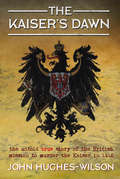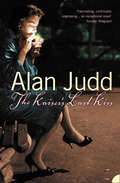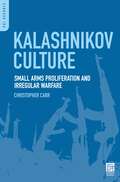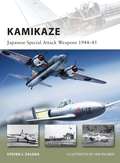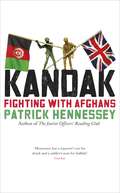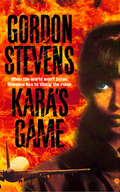- Table View
- List View
The Kaiser's Dawn: The Untold Story of Britain’s Secret Mission to Murder the Kaiser in 1918
by John Hughes-WilsonIn mid summer 1918 a top secret mission, which has remained classified information for a century, was set in motion to kill Kaiser Wilhelm II. It was felt that by killing their head of state and commander in chief it would serve as a mortal blow to the German forces and they would collapse very quickly after the assassination. The facts are borne out in never-before-published notebooks, maps and pilots’ flying records, kept secret for a hundred years. The implications of this secret attack raise many new – and explosive - questions. Exactly who ordered an attack to kill the Kaiser? Was it sanctioned by the C-in-C, Sir Douglas Haig? By the War Office? Was the King informed of the attempt to kill his royal cousin? Was Lloyd George, the Prime Minister asked? We do not know; but someone in London must have sanctioned the attack. The Official History makes no mention of any attack, and public records say nothing. John Hughes-Wilson has woven an exciting and well-paced historical novel to mark this centennial event from the research on discovering this mission. The story, based on true events, looks at this long hidden secret and puts it into the context of the time. It explores areas rarely examined: secret service operations in 1914-18; dirty, undercover intelligence work; the very real political intrigues between Whitehall and the generals and the heroics of the aircrew of the day, whose life expectancy at one point in 1917 was only eleven days in action.
The Kaiser’s Last Kiss
by Alan JuddA fictionalised account of the Kaiser Wilhelm’s last years in Nazi-occupied Holland.
Kalashnikov Culture: Small Arms Proliferation and Irregular Warfare (PSI Reports)
by Christopher CarrThis work is a bridge between the failed/weak states' literature and that which examines issues relating to small arms proliferation. Carr investigates the cultural impact of the availability of these easy-to-come-by weapons. This cultural dynamic has a direct, and deadly impact on issues such as arms control, illegal and illicit trading, gun cultures, the nexus between criminality and militia warfare and the social impact of arms proliferation, and the struggle for weak states who attempt to govern. The case studies will appeal to those with regional or comparative interests. Although the tone is academic, the topics and the subject matter will make this book of interest to those outside of the academic community.The work takes the form of alternating chapters in which elements of Kalashnikov enculturation, for example the peculiar forms of aberrant economic activity that exist within Kalashnikov cultures, are paired with chapter-length mini-case studies, such as that dealing with armed gang movements in Jamaica, Papua New Guinea, and Brazil. The whole work is bounded by the contention that under certain conditions heavily weaponized societies create their own milieu, which in turn gives rise to communities that find ways to survive (and sometimes thrive) within an ambiance of chronic insecurity.
Kamchatka
by Marcelo FiguerasWinner of the 2012 Premio Valle Translation Prize Shortlisted for the 2011 INDEPENDENT FOREIGN FICTION PRIZEIn the forecourt of a petrol station outside of Buenos Aires, a father says goodbye to his son: 'Kamchatka,' he whispers softly into his ear. And then they part, forever. A ten-year-old boy lives in world of Superman comics and games of Risk - a world in which men have superpowers and boys can conquer the globe on a board game. But in the outside world, a military junta have taken power; and amid a political climate of fear and intimidation, people are beginning to disappear without trace... Kamchatka is a heartbreaking novel; set in Argentina during the bloody coup d'etat of 1976, it tells the enchanting story of a young boy trying to make sense of a world during a time of extraordinary upheaval.
Kamikaze: Japanese Special Attack Weapons 1944–45 (New Vanguard #180)
by Steven J. ZalogaThe destruction of much of the remainder of the Japanese fleet and its air arm in the later half of 1944 left the Japanese Home Islands vulnerable to attack by US naval and air forces. In desperation, the Imperial Japanese Navy proposed using “special attack” formations, or suicide attacks. These initially consisted of crude improvisations of conventional aircraft fitted with high-explosive bombs that could be crashed into US warships. Called “Divine Wind” (Kamikaze), the special attack formations first saw action in 1944, and became the scourge of the US fleet in the battles for Iwo Jima and Okinawa in 1945. In view of the success of these attacks, the Japanese armed forces began to develop an entire range of new special attack weapons. This book will begin by examining the initial kamikaze aircraft attacks, but the focus of the book will be on the dedicated special attack weapons developed in 1944. It also covers specialized suicide attack weapons such as anti-tank lunge mines.
Kamikaze: Japanese Special Attack Weapons 1944–45 (New Vanguard)
by Steven J. Zaloga Ian PalmerThe destruction of much of the remainder of the Japanese fleet and its air arm in the later half of 1944 left the Japanese Home Islands vulnerable to attack by US naval and air forces. In desperation, the Imperial Japanese Navy proposed using "special attack†? formations, or suicide attacks. These initially consisted of crude improvisations of conventional aircraft fitted with high-explosive bombs that could be crashed into US warships. Called "Divine Wind†? (Kamikaze), the special attack formations first saw action in 1944, and became the scourge of the US fleet in the battles for Iwo Jima and Okinawa in 1945. In view of the success of these attacks, the Japanese armed forces began to develop an entire range of new special attack weapons. This book will begin by examining the initial kamikaze aircraft attacks, but the focus of the book will be on the dedicated special attack weapons developed in 1944. It also covers specialized suicide attack weapons such as anti-tank lunge mines.
The Kamikaze Campaign 1944–45: Imperial Japan's last throw of the dice (Air Campaign)
by Mark LardasAn illustrated history of how Japan devised and launched a new kind of air campaign in late 1944 – the suicidal assaults of the kamikaze units against the approaching Allied fleets.As summer changed to autumn in 1944, Japan was losing the war. Still unwilling to surrender, Japan's last hope was to try to wear down US resolve enough to reach a negotiated settlement. Extraordinary measures seemed necessary, and the most extraordinary was the formation of Special Attack Units – known to the Allies as the kamikazes. The concept of organized suicide squadrons was first raised on June 15, 1944. By August, formations were being trained. These formations were first used in the October 1944 US invasion of the Philippine Islands, where they offered some tactical success. The program was expanded into a major campaign over the rest of the Pacific War, seeing a crescendo during the struggle for Okinawa in April through May 1945. This highly illustrated history examines not just the horrific missions themselves, but the decisions behind the kamikaze campaign, how it developed, and how it became a key part of Japanese strategy. Although the attacks started on an almost ad hoc basis, the kamikaze soon became a major Japanese policy. By the end of the war, Japan was manufacturing aircraft specifically for kamikaze missions, including a rocket-powered manned missile. A plan for a massive use of kamikazes to defend the Japanese Home Islands from invasion was developed, but never executed because of Japan's surrender in August 1945. Packed with diagrams, maps and 3D reconstructions of the attacks, this book also assesses the Allied mitigation techniques and strategies and the reasons and the degree to which they were successful.
The Kamikaze Campaign 1944–45: Imperial Japan's last throw of the dice (Air Campaign)
by Mark LardasAn illustrated history of how Japan devised and launched a new kind of air campaign in late 1944 – the suicidal assaults of the kamikaze units against the approaching Allied fleets.As summer changed to autumn in 1944, Japan was losing the war. Still unwilling to surrender, Japan's last hope was to try to wear down US resolve enough to reach a negotiated settlement. Extraordinary measures seemed necessary, and the most extraordinary was the formation of Special Attack Units – known to the Allies as the kamikazes. The concept of organized suicide squadrons was first raised on June 15, 1944. By August, formations were being trained. These formations were first used in the October 1944 US invasion of the Philippine Islands, where they offered some tactical success. The program was expanded into a major campaign over the rest of the Pacific War, seeing a crescendo during the struggle for Okinawa in April through May 1945. This highly illustrated history examines not just the horrific missions themselves, but the decisions behind the kamikaze campaign, how it developed, and how it became a key part of Japanese strategy. Although the attacks started on an almost ad hoc basis, the kamikaze soon became a major Japanese policy. By the end of the war, Japan was manufacturing aircraft specifically for kamikaze missions, including a rocket-powered manned missile. A plan for a massive use of kamikazes to defend the Japanese Home Islands from invasion was developed, but never executed because of Japan's surrender in August 1945. Packed with diagrams, maps and 3D reconstructions of the attacks, this book also assesses the Allied mitigation techniques and strategies and the reasons and the degree to which they were successful.
Kamikaze, Cherry Blossoms, and Nationalisms: The Militarization of Aesthetics in Japanese History
by Emiko Ohnuki-TierneyWhy did almost one thousand highly educated "student soldiers" volunteer to serve in Japan's tokkotai (kamikaze) operations near the end of World War II, even though Japan was losing the war? In this fascinating study of the role of symbolism and aesthetics in totalitarian ideology, Emiko Ohnuki-Tierney shows how the state manipulated the time-honored Japanese symbol of the cherry blossom to convince people that it was their honor to "die like beautiful falling cherry petals" for the emperor. Drawing on diaries never before published in English, Ohnuki-Tierney describes these young men's agonies and even defiance against the imperial ideology. Passionately devoted to cosmopolitan intellectual traditions, the pilots saw the cherry blossom not in militaristic terms, but as a symbol of the painful beauty and unresolved ambiguities of their tragically brief lives. Using Japan as an example, the author breaks new ground in the understanding of symbolic communication, nationalism, and totalitarian ideologies and their execution.
Kamikaze, Cherry Blossoms, and Nationalisms: The Militarization of Aesthetics in Japanese History
by Emiko Ohnuki-TierneyWhy did almost one thousand highly educated "student soldiers" volunteer to serve in Japan's tokkotai (kamikaze) operations near the end of World War II, even though Japan was losing the war? In this fascinating study of the role of symbolism and aesthetics in totalitarian ideology, Emiko Ohnuki-Tierney shows how the state manipulated the time-honored Japanese symbol of the cherry blossom to convince people that it was their honor to "die like beautiful falling cherry petals" for the emperor. Drawing on diaries never before published in English, Ohnuki-Tierney describes these young men's agonies and even defiance against the imperial ideology. Passionately devoted to cosmopolitan intellectual traditions, the pilots saw the cherry blossom not in militaristic terms, but as a symbol of the painful beauty and unresolved ambiguities of their tragically brief lives. Using Japan as an example, the author breaks new ground in the understanding of symbolic communication, nationalism, and totalitarian ideologies and their execution.
Kamikaze Diaries: Reflections of Japanese Student Soldiers
by Emiko Ohnuki-Tierney“We tried to live with 120 percent intensity, rather than waiting for death. We read and read, trying to understand why we had to die in our early twenties. We felt the clock ticking away towards our death, every sound of the clock shortening our lives.” So wrote Irokawa Daikichi, one of the many kamikaze pilots, or tokkotai, who faced almost certain death in the futile military operations conducted by Japan at the end of World War II. This moving history presents diaries and correspondence left by members of the tokkotai and other Japanese student soldiers who perished during the war. Outside of Japan, these kamikaze pilots were considered unbridled fanatics and chauvinists who willingly sacrificed their lives for the emperor. But the writings explored here by Emiko Ohnuki-Tierney clearly and eloquently speak otherwise. A significant number of the kamikaze were university students who were drafted and forced to volunteer for this desperate military operation. Such young men were the intellectual elite of modern Japan: steeped in the classics and major works of philosophy, they took Descartes’ “I think, therefore I am” as their motto. And in their diaries and correspondence, as Ohnuki-Tierney shows, these student soldiers wrote long and often heartbreaking soliloquies in which they poured out their anguish and fear, expressed profound ambivalence toward the war, and articulated thoughtful opposition to their nation’s imperialism. A salutary correction to the many caricatures of the kamikaze, this poignant work will be essential to anyone interested in the history of Japan and World War II.
Kamikaze Diaries: Reflections of Japanese Student Soldiers
by Emiko Ohnuki-Tierney“We tried to live with 120 percent intensity, rather than waiting for death. We read and read, trying to understand why we had to die in our early twenties. We felt the clock ticking away towards our death, every sound of the clock shortening our lives.” So wrote Irokawa Daikichi, one of the many kamikaze pilots, or tokkotai, who faced almost certain death in the futile military operations conducted by Japan at the end of World War II. This moving history presents diaries and correspondence left by members of the tokkotai and other Japanese student soldiers who perished during the war. Outside of Japan, these kamikaze pilots were considered unbridled fanatics and chauvinists who willingly sacrificed their lives for the emperor. But the writings explored here by Emiko Ohnuki-Tierney clearly and eloquently speak otherwise. A significant number of the kamikaze were university students who were drafted and forced to volunteer for this desperate military operation. Such young men were the intellectual elite of modern Japan: steeped in the classics and major works of philosophy, they took Descartes’ “I think, therefore I am” as their motto. And in their diaries and correspondence, as Ohnuki-Tierney shows, these student soldiers wrote long and often heartbreaking soliloquies in which they poured out their anguish and fear, expressed profound ambivalence toward the war, and articulated thoughtful opposition to their nation’s imperialism. A salutary correction to the many caricatures of the kamikaze, this poignant work will be essential to anyone interested in the history of Japan and World War II.
Kamikaze Diaries: Reflections of Japanese Student Soldiers
by Emiko Ohnuki-Tierney“We tried to live with 120 percent intensity, rather than waiting for death. We read and read, trying to understand why we had to die in our early twenties. We felt the clock ticking away towards our death, every sound of the clock shortening our lives.” So wrote Irokawa Daikichi, one of the many kamikaze pilots, or tokkotai, who faced almost certain death in the futile military operations conducted by Japan at the end of World War II. This moving history presents diaries and correspondence left by members of the tokkotai and other Japanese student soldiers who perished during the war. Outside of Japan, these kamikaze pilots were considered unbridled fanatics and chauvinists who willingly sacrificed their lives for the emperor. But the writings explored here by Emiko Ohnuki-Tierney clearly and eloquently speak otherwise. A significant number of the kamikaze were university students who were drafted and forced to volunteer for this desperate military operation. Such young men were the intellectual elite of modern Japan: steeped in the classics and major works of philosophy, they took Descartes’ “I think, therefore I am” as their motto. And in their diaries and correspondence, as Ohnuki-Tierney shows, these student soldiers wrote long and often heartbreaking soliloquies in which they poured out their anguish and fear, expressed profound ambivalence toward the war, and articulated thoughtful opposition to their nation’s imperialism. A salutary correction to the many caricatures of the kamikaze, this poignant work will be essential to anyone interested in the history of Japan and World War II.
The Kamikaze Hunters: The Men Who Fought for the Pacific, 1945
by Will IredaleThe Sunday Times Top Ten Bestseller.In May 1945, with victory in Europe established, the war was all but over. But on the other side of the world, the Allies were still engaged in a bitter struggle to control the Pacific. And it was then that the Japanese unleashed a terrible new form of warfare: the suicide pilots, or Kamikaze.Drawing on meticulous research and unique personal access to the remaining survivors, Will Iredale follows a group of young men from the moment they joined up through their initial training to the terrifying reality of fighting against pilots who, in the cruel last summer of the war, chose death rather than risk their country's dishonourable defeat and deliberately flew their planes into Allied aircraft carriers. A story of courage, valour and dogged determination, The Kamikaze Hunters is a gripping account of how a few brave young men helped to ensure lasting peace.
Kampfflieger: Bomber Crewman of the Luftwaffe 1939–45 (Warrior)
by Adam Hook Robert F StedmanThe Kampfflieger are relatively unknown within aviation circles, although many of them had careers as distinguished as those of their fighter-pilot counterparts. The men of the bomber crews did not enjoy the luxury of combat tours – they flew until they died or became unfit for combat duty. This book studies the attitudes, beliefs and motivation of the average crewman, following him through recruitment and training to experience on campaign in western Europe, Africa and the Russian front, detailing the exploits and trials of the famous Ju 87 'Stuka' dive-bomber crews and their own crucial part in Germany's war effort.
Kampfflieger: Bomber Crewman of the Luftwaffe 1939–45 (Warrior #99)
by Robert F StedmanThe Kampfflieger are relatively unknown within aviation circles, although many of them had careers as distinguished as those of their fighter-pilot counterparts. The men of the bomber crews did not enjoy the luxury of combat tours – they flew until they died or became unfit for combat duty. This book studies the attitudes, beliefs and motivation of the average crewman, following him through recruitment and training to experience on campaign in western Europe, Africa and the Russian front, detailing the exploits and trials of the famous Ju 87 'Stuka' dive-bomber crews and their own crucial part in Germany's war effort.
KANDAK: Fighting with Afghans
by Patrick HennesseyFrom the author of the top ten bestseller The Junior Officers' Reading Club. When Patrick Hennessey returned home from Afghanistan, battle-worn, exhilarated, unsure if he'd see anything like it in his life again, he left behind him bands of friendship forged in the heat of the moment between living and dying. The comrades he left furthest behind were Qiam, Syed and Majhib. They are still there in the dust and heat of Helmand, soldiers fighting for their homeland. KANDAK is the story of how these lasting bonds were made. Written in the spare and lucid prose of Junior Officers' Reading Club, Patrick Hennessey tells of their comically bad first meetings, the mutual suspicion, incomprehension and cultural divides that characterise early interactions between British and Afghan soldiers, to the moments under fire when those divides can, sometimes, cross chaos and culture shocks to turn into brotherhood. An account of friendship and loss, of warriors and soldiers, KANDAK explores the reasons men pick up the sword, and how in the intensity of battle, unlikely alliances can be formed.
Kangaroo Squadron: American Courage in the Darkest Days of World War II
by Bruce GambleIn early 1942, while the American military was still in disarray from the devastating attacks on Pearl Harbor and the Philippines, a single U.S. Army squadron advanced to the far side of the world to face America's new enemy.Based in Australia with inadequate supplies and no ground support, the squadron's pilots and combat crew endured tropical diseases while confronting numerically superior Japanese forces. Yet the outfit, dubbed the Kangaroo Squadron, proved remarkably resilient and successful, conducting long-range bombing raids, carrying out armed reconnaissance missions, and rescuing General MacArthur and his staff from the Philippines.Before now, the story of their courage and determination in the face of overwhelming odds has largely been untold. Using eyewitness accounts from diaries, letters, interviews, and memoirs, as well as Japanese sources, historian Bruce Gamble brings to vivid life this dramatic true account.But the Kangaroo Squadron's story doesn't end in World War II. One of the squadron's B-17 bombers, which crash-landed on its first mission, was recovered from New Guinea after almost seventy years in a jungle swamp. The intertwined stories of the Kangaroo Squadron and the "Swamp Ghost" are filled with thrilling accounts of aerial combat, an epic survival story, and the powerful mystique of an invaluable war relic.
Kangaroo Squadron: American Courage in the Darkest Days of World War II
by Bruce GambleIn early 1942, while the American military was still in disarray from the devastating attacks on Pearl Harbor and the Philippines, a single U.S. Army squadron advanced to the far side of the world to face America's new enemy. Based in Australia with inadequate supplies and no ground support, the squadron's pilots and combat crew endured tropical diseases while confronting numerically superior Japanese forces. Yet the outfit, dubbed the Kangaroo Squadron, proved remarkably resilient and successful, conducting long-range bombing raids, carrying out armed reconnaissance missions, and rescuing General MacArthur and his staff from the Philippines. Before now, the story of their courage and determination in the face of overwhelming odds has largely been untold. Using eyewitness accounts from diaries, letters, interviews, and memoirs, as well as Japanese sources, historian Bruce Gamble brings to vivid life this dramatic true account. But the Kangaroo Squadron's story doesn't end in World War II. One of the squadron's B-17 bombers, which crash-landed on its first mission, was recovered from New Guinea after almost seventy years in a jungle swamp. The intertwined stories of the Kangaroo Squadron and the "Swamp Ghost" are filled with thrilling accounts of aerial combat, an epic survival story, and the powerful mystique of an invaluable war relic.
The Kappillan of Malta (Sven Hassel War Classics)
by Nicholas Monsarrat'One of the most memorable characters of post-war fiction' Daily ExpressA classic novel set in the siege of Malta 1940-1942 from the bestselling author of The Cruel SeaFather Salvatore was a simple, lumbering priest, a Kappillan serving the poor Valetta, when war came out of the blue skies to pound the island to dust.Now amid the catacombs discovered by a chance bomb, he cared for the flood of homeless, starving, frightened people who sought shelter from the death that fell unceasingly from the sky.His story, and the story of Malta, is told in superbly graphic pictures of six days during the siege. Each of those days brought forth from the Kappillan a message of inspiration to keep them going - the legendary tales of six mighty events of Malta's history which shone through the centuries and gathered them together in a fervent belief in their survival.
Kara’s Game
by Gordon StevensA SAS group, led by a man called Finn, is operating in Bosnia, directing air strikes against Serb positions. They are attacked but their lives are saved by a Muslim woman, Kara. Kara's game is altogether bigger, more shocking and more important.
Karl Doenitz and the Last Days of the Third Reich
by Barry TurnerAmong the military leaders of the Second World War, Grand Admiral Karl Doenitz remains a deeply enigmatic figure. As chief of the German submarine fleet he earned Allied respect as a formidable enemy. But after he succeeded Hitler – to whom he was unquestioningly loyal – as head of the Third Reich, his name became associated with all that was most hated in the Nazi regime. Yet Doenitz deserves credit for ending the war quickly while trying to save his compatriots in the East – his Dunkirk-style operation across the Baltic rescued up to 2 million troops and civilian refugees. Historian Barry Turner argues that while Doenitz can never be dissociated from the evil done under the Third Reich, his contribution to the war must be acknowledged in its entirety in order to properly understand the conflict. An even-handed portrait of Nazi Germany’s last leader and a compellingly readable account of the culmination of the war in Europe, Karl Doenitz and the Last Days of the Third Reich gives a fascinating new perspective on a complex man at the heart of this crucial period in history.
The Karma Booth
by Jeff PearceThey say that executing a murderer won't bring your loved one back. But now it can.
Kashmir at the Crossroads: Inside a 21st-Century Conflict
by Sumantra Bose[Written] with admirable clarity' Literary Review'Excellent . . . concise and chilling' IndependentAn authoritative, fresh, and vividly written account of the Kashmir conflict?from 1947 to the present.The India-Pakistan dispute over Kashmir is one of the world’s incendiary conflicts. Since 1990, at least 60,000 people have been killed?insurgents, civilians, and military and police personnel. In 2019, the conflict entered a dangerous new phase. India’s Hindu nationalist government, under Narendra Modi, repealed Indian-administered Jammu and Kashmir’s autonomous status and divided it into two territories subject to New Delhi’s direct rule. The drastic move was accompanied by mass arrests and lengthy suspension of mobile and internet services.In this definitive account, Sumantra Bose examines the conflict in Kashmir from its origins to the present volatile juncture. He explores the global context of the current situation, including China’s growing role, as well as the human tragedy of the people caught in the bitter dispute. Drawing on three decades of field experience in Kashmir, Bose asks whether a compromise settlement is still possible given the ascendancy of Hindu nationalism in India and the complex geopolitical context.
Kashmir at the Crossroads: Inside a 21st-Century Conflict
by Sumantra Bose[Written] with admirable clarity' Literary Review'Excellent . . . concise and chilling' IndependentAn authoritative, fresh, and vividly written account of the Kashmir conflict?from 1947 to the present.The India-Pakistan dispute over Kashmir is one of the world’s incendiary conflicts. Since 1990, at least 60,000 people have been killed?insurgents, civilians, and military and police personnel. In 2019, the conflict entered a dangerous new phase. India’s Hindu nationalist government, under Narendra Modi, repealed Indian-administered Jammu and Kashmir’s autonomous status and divided it into two territories subject to New Delhi’s direct rule. The drastic move was accompanied by mass arrests and lengthy suspension of mobile and internet services.In this definitive account, Sumantra Bose examines the conflict in Kashmir from its origins to the present volatile juncture. He explores the global context of the current situation, including China’s growing role, as well as the human tragedy of the people caught in the bitter dispute. Drawing on three decades of field experience in Kashmir, Bose asks whether a compromise settlement is still possible given the ascendancy of Hindu nationalism in India and the complex geopolitical context.
